| Travelogue
China Revisited
Z Tariq Ali
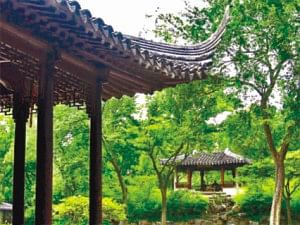 |
Suzhou Garden. |
As the train picked up speed, the landscaped countryside reminded me of a ride from Switzerland to France many years ago. Even in the US, landscaping is not something that railway companies would waste their money on. I was travelling in the famous fast train from Nanjing to Suzhou introduced just a month ago. It was to be quite a different journey that I was making 17 years later, compared to the five hour dirt and coal-dust smudged journey that we used to have to make between Nanjing and Suzhou. I looked up and the electronic board read, “Speed- 311 km/hr.” Contrary to my expectation that this would be like riding on a bullet, it felt like any other train ride and the receding countryside did not give the impression that we were travelling at half the speed of an airline while still on the ground.
The fastest train in India that is what I have been told--is the Shatabdi Express which clocks 130 km on a short stretch between Mumbai and Ahmedabad and that train looked like a relic from the past compared to this-on-e-a sleek white arrow. The Nanjing Railway terminal, a glass and steel building, true, had traces of dust collecting on the gigantic steel frame forty feet above, and its glass panels were not really sparkling in the sunlight something un-Chinalike, but otherwise it was like any European metro station, with platforms so clean that you could eat off the shining floor. Slot machines restricted platform entry until 15 minutes before departure and there were no vendors.
The new train station, being built near the city perimeter will, I was told, be the biggest railway station in Asia. Mr. Wang from the Nanjing Massacre Museum, where I had read a paper on the Bangladesh Liberation War, had bid me a tearful farewell at the station, saying “you are like my father”. This was China. Traditions had not been given up. A proud people, assertive about their place in history. And why not? That place in history had begun here with the first attempts at crop domestication 9,500 years ago, just 500 years behind the Fertile Crescent. And since then, China had remained, unlike any other cradle of civilization, one uninterrupted civilization. Today it is a nation that has placed its trust in the spirit of its people and has not veered away from that trust, like the Soviets had done when they fell apart. A strikingly innovative part of the museum's anniversary celebrations this year had been the 6,830 pairs of empty shoes, neatly arranged in rows, signifying 6,830 of the unfortunate Chinese who could not survive the ordeal of forced labour that the Japanese had imposed on them in Japan.
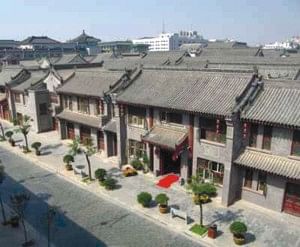 |
The ancient city of Xian. |
I arrived at Suzhou to find the familiar old railway station gone and found my friend waiting for me outside the new station. The old parking lot beside the river was being converted into a garden and the new one was underneath the station itself. As we drove into the city I could see that the old city and the maple trees had been preserved. Two new cities, flanking the old one had been built. The first was jointly owned by Singapore and Suzhousomething that the Singaporeans had contemplated for Kolkata before an ignoramus Mamta Banerjee had ruined West Bengal's chances for this century. The second was a high- technology city built by the government. Like India, China is training its people on higher technology professions instead of brute labour. That commitment is manifested in the revised curriculums of science and technology in their secondary schools. It rivalled the Scandinavian and Singapore curriculums in the emphasis on science, mathematics and application of logicsomething sadly lacking in our curriculum. I had asked Mr. Wang about his beliefs. He had none, he said. “True, some of us would light a candle in Buddha's name in times of personal distress, but it is only prophylactic and most of us do not need religion.” I had asked my interpreter the same question 17 years ago and she had given me the same answer.
Old Suzhou had retained its charm. As each city grows, it is encircled by the first and subsequent elevated ring roads. Xian's ring roads in particular reminded me of Houston. Highways which rival the NJ Turnpike in quality connect one city with the other. The state-run engineering company that we used to sneer at when we worked here and had often expressed doubts about their ability to design and build the first underpass on the Renmin Road had designed the city metro now. The first of these lines will go into operation by the end of the year, on schedule. They are not chicken hearted like all our government functionaries have been since 1972. They have the instinctive capacity to think on a grand scale. The only Bengali I have come across who thinks big is Sir F. H. Abed. None of the Chinese projects get holed up for years in administrative muck in their own country. The same of course, is not true about the projects that they build overseas. This is true particularly of the power plants they had built in Bangladesh. They were of rotten quality, as corroborated by the PDB engineers who hadn't partaken of the booty that was distributed and each of these projects were straddled with delays. The projects that the Chinese are doing currently in Africa fare even worse. Who do you blame? I am a witness to the sudden affluence of the officials of the Bangladesh textile corporation after 1972, when the Indian businessmen had supplied to Bangladesh the equivalent of gamchas for saris.
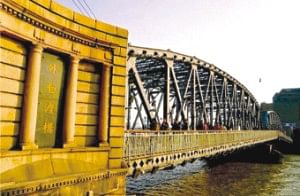 |
Bridge over Suzhou River. |
I checked in at the Bamboo Grove Hotel, where I used to live and immediately got struck with nostalgia. I looked out of my window into the Suzhou Garden built in the courtyard. The hotel hadn't changed much and was as charming as it used to be 17 years ago but some dear friends that I had then were no longer in Suzhou. As I recalled those moments I felt a sigh go up my chest. I remember how one day, late into the night, my colleague fell in the bathroom and had to be taken to the nearby hospital. Despite fears that no doctors would be available and it would be dirty and smelly, the hospital was spick and span, the equipment was working and the doctor was not taking a nap. We returned home after being treated, all within one hour. The price that we as foreigners were required to pay was the equivalent of 6 cents. No longer, though. China had in the meantime become expensive. I had to buy Ibuprofen from a pharmacy this time and twenty capsules cost me the equivalent of Tk. 180.
The evening was a lot of drinking and fun with old colleagues and we recounted the gaffes and peculiarities that various people in the project had. Although previously all our conversation had to be conducted through the interpreter, most of them could now converse in English. A covered bowl was served containing live shrimp (kucho-chingri) dipped in rice wine, which we ate up, without even bothering with their flailing legs. Since I had become a sashimi fan, I did not revolt as I had done many years ago in Rome, eating for the first time, marinated squid. The only Chinese food that I have not been able to stomach in my many years in China is skinned, de-headed and boiled mice.
We visited the plant the next day and they were now making 6 billion tablets a year and their blender sizes are 2 cum. The size of the QC lab is 1,500 sqm. and they have an astounding 22 HPLC and two AA machines there. They have a German and an American working in the lab as technicians. I enquired with my friends about a particular remnant of the British Raj, who had worked here as the second plant manager. He had raised his hand on his driver one day and not only was he fired on the spot, he was made to leave China.
The Suzhou river had been cleaned up and gone were the chemical plants spewing out pollutants in the air and into the river on both sides. The two banks today wore a thick veil of green. Imagine what the Buriganga waterfront would have looked like if we did that in Dhaka, leaving intact the stately buildings of the Ahsan Manzil and the Ruplal House and perhaps Mr. Wize's home with its staircase.
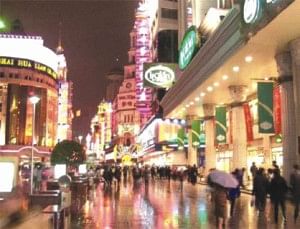 |
Dazzling Shanghai. |
The company driver took me to Shanghai the next day along the highway which in 1993 was only a ten foot wide country road with pot holes that would match the roads in our moffussil towns, and on whose surface people would dry their rice crop, just as we do today. It was a four-lane highway now. The old two-family farmer homes on the roadside were largely abandoned because most of the farmers had gone over to the cities as industrial workers. And strangely, at the beginning of the Deng Shiao Ping revolution, it was the farmers that were the more affluent class. The first private car in China in the late seventies, I remember, was owned by a farmer family. Even in 1993, I used to be dismayed that every inch of the agricultural land between Shanghai and Suzhou was being gobbled up by industries. But that is, I believe inevitable and I wonder whether it is worth shedding tears overt. The world population will increase to a size where agriculture will have to be more efficient, to the point that all our grains, vegetables and meat will perhaps be manufactured industrially in fermentation vats in the next century. Food habits therefore, will have to change. People of our generation will remember what a nose-drubbing we had given Monaem Khan when he talked of introducing “bhutta” as one of the staples in our country. Today, I see garment workers in the streets of Dhaka chomping up a cob or two for lunch with relish.
In 1993 I would know that I was approaching Shanghai when I saw farmers in bicycles carrying their slaughtered pigs slung on the two sides of the carrier of their bicycle to the Shanghai wholesale market. Gone were those men and their bikes. Talking about bikes, it was a breathtaking sight on the Shanghai streets in the late 1980s with 70-deep bikes along the Shanghai streets between 7.30 and 8 in the morning. There are occasional bikes and “thelas” on the Nanjing roads today but they do not cause traffic congestion. Unlike the failed Dhaka experiment, limiting them to one lane has worked here. And in stark contrast to what has happened in Dhaka, the growing affluence here has also bred a bit of civic responsibility amongst the drivers and the driven.
I asked the driver to take me around Shanghai as the only work I had there was to visit with an Indian diplomat in the evening who had been based in Dhaka once. Many of the skyscrapers and shopping malls that were new and looked so wonderful in 1993 had themselves been replaced by futuristic buildings. Gone certainly were all the slums in Shanghai. I am sure that the slum-dwellers had been adequately relocated. The driver told me that any place between Pudong and Puxi was within a 30 minute drive if you took the expressways. I remember that the ferry between Pudong and this side was as antiquated and as dangerously juxtaposed as the ferries we have on our rivers today, only that they were run more efficiently, even in those days. Shanghai has 3 bridges and a tunnel now on the Huangpu River. The bund area, I was pleased to see, was preserved in its old glory and underneath the garden along the bund ran a three lane highway for fast traffic. The busy streets have big signs with changing red, amber and green strips indicating where you could encounter traffic congestions at that moment. I went around the French and English quarters. The residential buildings were still resplendent in their stately charm, something that Camac or Mullen Streets of Kolkata must have looked like in the 1900s.
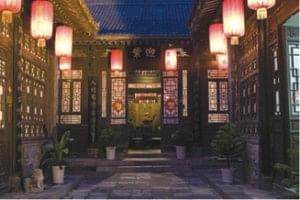 |
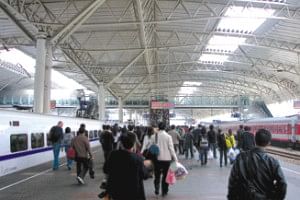 |
The ancient city of Xian has many unknown treasures. |
Nanjing Station. |
I was going to the ancient city of Xian now, famed for its terracotta soldiers and horsemen. It was discovered in 1974 and they have done a good job in creating facilities that would make it attractive to foreign tourists. However, food, sold even by street vendors was 10 times more expensive than it was in 1993. While in Nanjing I had searched in vain for my favourite dossa breakfast, cooked while you waited with an egg spread on top and coming with a generous filling of sautéed greensall for 1 Yuan. I was told it sold for 10 Yuan now. But going back to Xian--most tour guides were speaking in Mandarin and so most of the tourists must be from China, Hongkong or Taiwan. Xian has a city wall from the Ming period like Nanjing and Beijing does. It is about 40 ft high and with a width of 50 ft. with four gates, all very well preserved. Xian is also building its own metro. Here for the first time I saw cars and taxis wiggle through the smallest of the street space just like we do in Dhaka. But no taxi would have the gall to refuse to go anywhere, no matter how short the distance was. They run on CNG of which price is about double the Dhaka price, i.e. no state subsidies. On the way to Xian, I had the opportunity to watch two flights take off to controversial places within China. The flight to Lasha was half full and there was a sprinkling of Tibetan faces there. But the flight to Urumchi was completely packed and there was not one Uighur face amongst the 150 or so passengers. All of them were Han Chinese. This is what we are doing to the Chittagong Hill Tracts, encouraging non-indigenous settlers. Most of the flights on the internal routes were quite full and local Chinese tourists do travel quite a bit, especially as this was summertime. I could not get a sleeper seat on any of the long distance trains, although I had tried 15 days in advance.
The last leg of my journey took me to Kunming, and here I found similarities with Dhaka. The buildings were shabby and the city planning did not exude the sophistication inherent in the other cities. There was dirt in the atmosphere, something that I had not encountered in the other cities, even where construction was going on. The roads were dirty and for the first time in my 15 days I found quite a few people spitting, with abandon. A false health alarm had prevented me from risking the tour to the stone forests which I had booked earlier and so I spent the entire day in bed reading the heavy book which it now turned out was worth carrying all this way. And to make Bengalis feel at home, there was a power cut in the area which lasted five hours. My flight to Dhaka was the next day and like all other flights taken on this journey, it made up for the 30 minute delay and I could see the sun glinting on the ubiquitous Bangladesh tin roofs within an hour and quarter after take off.
The writer is a social worker and Trustee, Liberation War Museum.
Copyright
(R) thedailystar.net 2010 |
|
